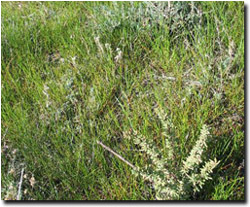Research
Eco-Rich Grazing | Project Team | Publications | Photos | Project Location | Research | Related Links
Project Research
The Eco-rich Grazing project aims to provide farmers and land managers with information and skills to better manage remnant native grasslands so that biodiversity values are enhanced and profitability is maintained on the farm as a whole.
The early stages of the project involved a thorough review of the literature to collate what is already known about native grassland management. Market research was also conducted to gain a better understanding of the attitudes and concerns of farmers and land managers in relation to native grassland conservation. See the publications page for the associated report written by ‘Down to Earth Research’. In addition to market research, a series of one-on-one interviews were held with six farmers who manage native grassland on their properties – located within the Volcanic Plains and Northern Riverina. Farmers were asked to share their experiences and opinions on a range of topics such as family history of the farm, perceptions of biodiversity, grazing management practices used and the biggest threats they believed were posed to native grasslands.
The Eco-rich Grazing project focuses on two main areas of experimental research: grazing management on the Volcanic Plains of Western Victoria and Bluebush establishment on the Victorian Riverina Plain.
Grazing Management Experiments-Volcanic Plains
Three experiments have been established on the Volcanic Plain of Western Victoria. They are situated on farms at Hamilton, Darlington and Birregurra. Using an open communal design each site consists of six grazing management treatments: never grazed, always grazed, winter rest, early spring rest, summer rest, and a combined spring/summer rest. Sheep are excluded from the plots being rested through the closure of gates at the appropriate time. The impact on herbage availability, species richness and sward structure as a result of the 6 treatments is being examined. The results of these experiments over several years will be used to develop ‘best practice’ grazing management guidelines for farmers with native grassland.
Replicate 1 | Replicate 2 | Replicate 3 |
Always Grazed | Summer Rest | Always closed |
Never Grazed | Spring/Summer Rest | Summer Rest |
Spring Rest | Always Grazed | Winter Rest |
Winter Rest | Always closed | Spring/Summer Rest |
Summer Rest | Spring Rest | Always Grazed |
Spring/Summer Rest | Winter Rest | Spring Rest |
Rhinannon Apted has also been undertaking an honours research project on these experimental sites. Her research, examining the response of five native forb species to different grazing treatments, is supervised by Dr John Morgan (LaTrobe University) and Dr Josh Dorrough (DSE). Interestingly Rhiannon found that at some sites young seedlings suffered heavy defoliation from introduced slug species. Apparently these slugs, which are major pests in crops and improved pastures, have invaded native pastures and may be a major factor limiting early establishment of some native forb species. Her project is due for completion in May 2005.
Bluebush Establishment Experiments-Northern Riverine Plains of Victoria
Historical evidence and recent studies indicate that the Victorian Riverine Plain originally supported deep-rooted, summer-active (C4) perennial grasses and chenopod shrubs such as bluebush (Maireana spp.). These have been replaced by cool-season annual and perennial grasses, significantly reducing the length of the growing season. Deep-rooted perennials enhance soil stability and water infiltration and reduce water table levels thus helping to prevent dryland salinity. Shrubs such as bluebush provide fodder over summer and during droughts. This component of the project is examining methods of establishing bluebush into grasslands under cereal crops.
In this experiment we investigated the effects of over-sown cereal crops on establishment, growth and survival of two native bluebush chenopod species, Maireana decalvans and Maireana rohrlachii. Both species are thought to have been widespread on the Riverine Plains prior to agricultural intensification, although the abundance of M. rohrlachii in particular has been reduced by a combination of livestock grazing and cultivation. While M. decalvans is common in areas with a history of grazing and cropping, M. rohrlachii is restricted to isolated areas with low grazing pressure and an absence of cropping (i.e. on roadsides). The following hypotheses were examined through this experiment:
1) Native chenopods sown under cereal crops have improved establishment, growth and survival.
2) The establishment, growth and survival of M. rohrlachii is lower than that of the more resilient M. decalvans.
 Maireana sp. growing under a wheat crop in the Northern Riverine | A matrix of wheat and Maireana plots was sown at three sites along the Mitiamo-Echuca road. Plots were 8 m x 1.5m. Treatments were wheat at 4 sowing rates (including zero) x each Maireana species at 3 sowing rates (including zero). Three replicates were used at each site. The wheat was mechanically drilled and the Maireana seed was hand sown and lightly raked over. Data collection included establishment density counts, plant height, flowering observations, seed production and biomass. The cover, diversity and biomass of other species present were also assessed. |
In conjunction with this project, Nathan Wong undertook an honour research thesis supervised by Dr John Morgan (LaTrobe University) and Dr Josh Dorrough (DSE). His research examined patterns and processes of plant community change following cultivation in the Riverine Plains. His research suggested that recovery of native plant communities post-cultivation was seed limited. Because many native species are becoming increasingly rare at a landscape scale, future recovery will be slower than historical rates.


